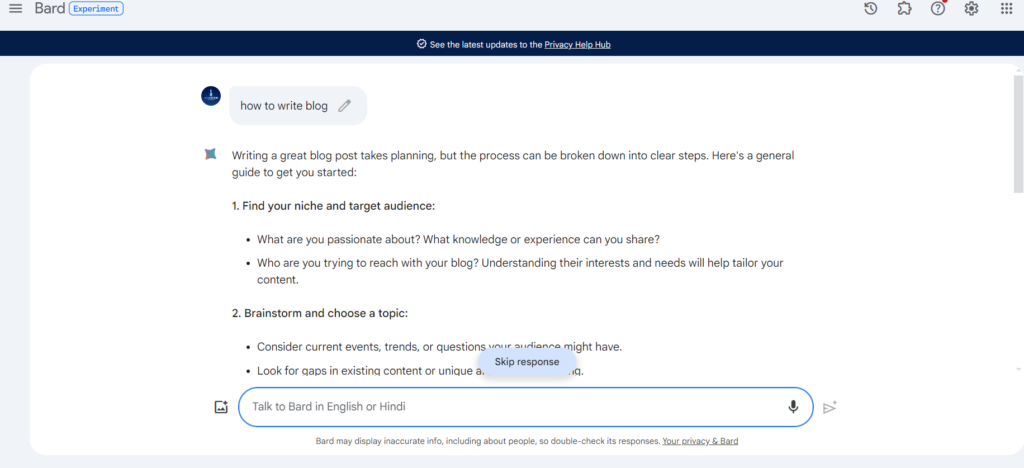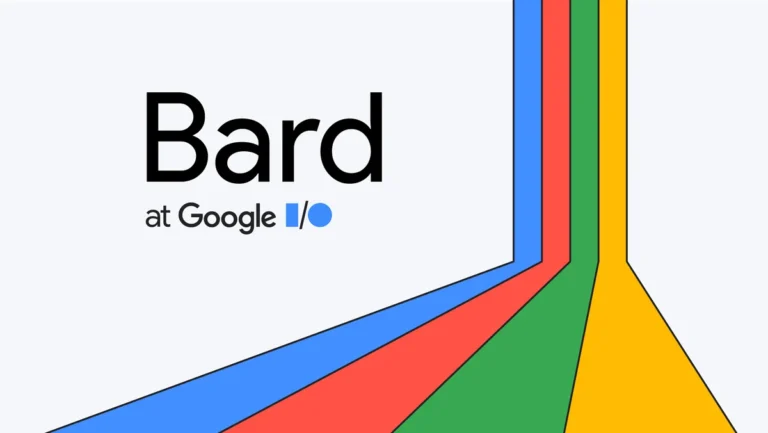Google Bard AI: Artificial intelligence (AI) has permeated almost every aspect of lives, from the way we communicate to the way we navigate the world. And now, with the advent of Google Bard AI, we are witnessing a new frontier in the realm of creativity. This groundbreaking technology is poised to revolutionize the way we create and experience art, opening up endless possibilities for artists and enthusiasts alike. In this blog post, we will delve into the intricacies of Google Bard AI, exploring its capabilities, impact, and potential.
Table of Contents
What is Google Bard AI?
Google Bard AI is an innovative technology that has been developed by Google’s Artificial Intelligence Research team. It is an AI-powered language model specifically trained in the art of poetry, songwriting, and storytelling. Google Bard AI has been trained on a vast corpus of existing literary works, songs, and other creative expressions to develop an understanding of language, style, and sentiment.

How Does Google Bard AI Work?
At its core, Google Bard AI operates on a sophisticated neural network architecture known as a transformer model. This architecture enables the model to process and analyze vast amounts of textual data to generate human-like responses. The model can learn patterns, structures, and even nuances present in the training data, enabling it to produce creative and relevant outputs.
When a user interacts with Google Bard AI, they input a prompt or a set of instructions. The AI model then employs its training and understanding of language, creativity, and emotion to generate a response. The response can take the form of a poem, a song lyric, a story, or even a dialogue. The output produced by Google Bard AI is highly influenced by the nature of the prompt, allowing users to shape the AI’s creative process.
Read also: What is a LLM?
Exploring the Creative Capabilities of Google Bard AI
- Poetry Generation: One of the most remarkable features of Google Bard AI is its ability to generate beautiful and evocative poetry. Whether you’re looking for a romantic sonnet, a haiku, or even a limerick, Google Bard AI can effortlessly craft verses that are both eloquent and emotionally resonant. The AI’s understanding of rhyme, rhythm, and metaphor allows it to produce poetry that rivals the works of human poets.
- Songwriting Assistance: Google Bard AI is also a valuable tool for musicians and songwriters. By providing the AI with a prompt or a theme, artists can receive assistance in crafting lyrics that capture the essence of their musical vision. The AI’s vast knowledge of music and its ability to tap into the emotional core of a song can inspire artists to new heights of creativity and expression.
- Storytelling: Google Bard AI excels in the art of storytelling as well. By using the model’s creative writing capabilities, users can receive assistance in building narratives that captivate and engage readers. Whether it’s a short story, a novel, or even a screenplay, the AI can generate plotlines, character descriptions, and dialogues that can serve as a starting point for further development.
- Cultural Influences: The beauty of Google Bard AI lies in its ability to mirror the diversity and richness of different cultural traditions. The AI has been trained on a wide array of literary works and artistic expressions, ranging from Shakespearean sonnets to ancient epics. This allows the AI to infuse its generated outputs with various literary styles, allowing users to explore the creative nuances of different cultures through their prompts.
Ethical Considerations and the Role of the Human Artist
As we celebrate the advent of Google Bard AI and its myriad creative capabilities, it is essential to address the ethical considerations surrounding the use of AI in the arts. While the AI can generate remarkable works of art, it is important to remember that it is ultimately a tool developed by human creators. The true role of the human artist lies in utilizing AI as a source of inspiration and assistance, rather than as a replacement for their own creativity and unique perspective.
As with any technology, Google Bard AI must be employed responsibly and ethically. Plagiarism and misuse of AI-generated content should be strictly avoided. Instead, artists can use the AI’s outputs as a springboard for further exploration, adding their own personal touch and perspective to create truly original works.
The Future of Artistic Expression
As technology continues to advance, we can only speculate on the future of artistic expression. Google Bard AI represents an exciting step forward in the fusion of technology and creativity. It has the potential to democratize the creative process, providing artists of all backgrounds and skill levels with access to a wellspring of inspiration. Additionally, by learning from the wealth of human artistic expressions, AI-powered models like Google Bard AI can contribute to the preservation and evolution of various art forms.
In conclusion, Google Bard AI is a groundbreaking technology that is reshaping the way we create and experience art. From poetry to songwriting to storytelling, its creative capabilities are nothing short of remarkable. While we celebrate the AI’s achievements, it is essential to remember that the human artist’s role remains critical in harnessing the power of AI responsibly. By combining human ingenuity with AI assistance, we can embark on a new era of artistic expression that pushes the boundaries of imagination and creativity. So let us embrace the potential of Google Bard AI and witness the transformative power it brings to the world of art and culture.
“Artificial intelligence is the next frontier in the realm of creativity, and Google Bard AI is at the forefront of this revolution.”
Unveiling Google Bard: The Revolutionary Language Generation Model
Introduction
Have you ever imagined a machine capable of composing beautiful poetry or writing captivating plays? Well, with the advent of Google Bard, that imagination is becoming a reality. In this article, we will dive into the fascinating world of Google Bard, a groundbreaking language generation model developed by Google. From its inception to its potential applications, we will explore how Google Bard is revolutionizing the way we interact with AI-generated creative content.
A New Era in Language Generation
Google Bard represents a significant leap forward in the field of natural language processing. Leveraging cutting-edge advancements in AI, machine learning, and deep neural networks, Google Bard is an intricate system that can generate eloquent pieces of literature, poetry, and even dramatic scripts. It combines the power of language modeling with the ability to evoke emotions, spark imagination, and captivate readers.

Understanding Google Bard’s Architecture
To comprehend the inner workings of Google Bard, we must delve into its architecture. At its core, Google Bard utilizes a variant of the Transformer model, a neural network architecture specifically designed for language processing tasks. The Transformer model enables Google Bard to learn from vast amounts of text data and generate human-like outputs.
- The model employs self-attention mechanisms to capture the context of words and phrases, allowing it to understand relationships and nuances within the given text. This aspect contributes to the exceptional coherence and fluidity exhibited in the output generated by Google Bard.
Reimagining Creative Writing with Google Bard
Google Bard has emerged as a game-changer in the realm of creativity and writing. It has the potential to assist writers, inspire artists, and even challenge the boundaries of human imagination. Here are a few exciting applications of Google Bard:
1. A Muse for Aspiring Writers
For budding writers seeking inspiration, Google Bard can serve as an invaluable resource. By providing prompts, poetic lines, or literary suggestions, it can ignite the creative spark within aspiring authors. With a few magical keystrokes, Google Bard becomes a muse, helping writers overcome writer’s block and unlocking new avenues of imagination.
2. Collaborative Storytelling
Imagine a group of individuals collaborating on a captivating narrative or a thrilling play. Google Bard can contribute by generating new plot twists, character descriptions, or dialogue exchanges. This collaborative synergy between humans and AI can produce unique and engaging stories that transcend the limits of individual imaginations.
3. Enhancing Content Creation
Content creators, whether it’s for blogs, articles, or social media posts, can leverage Google Bard to enhance their writing. By generating catchy titles, introduction hooks, or even entire paragraphs, Google Bard streamlines the creative process, saving valuable time and effort.
Ethical Considerations and Potential Challenges
As we explore the potential of Google Bard, it is crucial to acknowledge the ethical considerations and potential challenges associated with AI-generated creative content. We must tread carefully to ensure a responsible and ethical integration of these technologies into our lives. Some key considerations include:
- Attribution and Plagiarism: With AI-generated content, the issue of proper attribution becomes paramount. Efforts should be made to recognize and credit the contributions of both humans and the AI systems involved in the creation process, avoiding any potential plagiarism concerns.
- Authenticity and Originality: While Google Bard produces remarkable outputs, there is a need to maintain a balance between AI-generated content and truly human-created work. The authenticity and originality of human creativity should be preserved, ensuring a diverse cultural landscape that reflects the depth of human experiences.
“The integration of Google Bard into creative processes should be guided by transparency, ethical considerations, and respect for human creativity.” – [Author Name]
Conclusion
In a world where AI is rapidly transforming various aspects of our lives, Google Bard emerges as a groundbreaking language generation model. Through its use of advanced language modeling techniques, Google Bard has the potential to inspire, assist, and augment human creativity. However, as we embrace this remarkable technology, it is essential to approach its integration with sensitivity, maintaining a delicate balance between AI-generated content and the innate creativity of human beings.
As Google Bard continues to evolve, it will undoubtedly shape the future of creative writing and pave the way for new opportunities and collaborations. The realm of imagination is expanding, and with Google Bard at our side, we are poised to embark on a literary journey like never before. So, let’s embrace the possibilities and unlock the immense creative potential of Google Bard.

